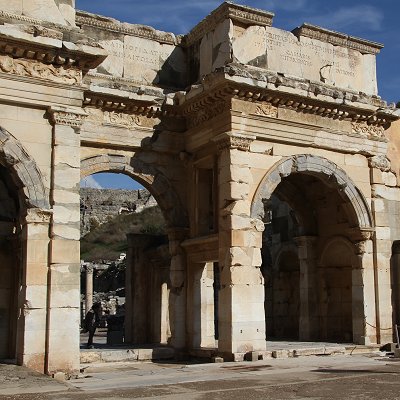
Like us on Facebook
PLACE NAMES


 
|
|
İzmir
|

|
| |
|

Izmir, is a metropolitan city in the western extremity of Anatolia. It is the third most populous city in Turkey, after Istanbul and Ankara; and the second largest urban agglomeration on the Aegean Sea after Athens.
In 2019, the city of Izmir had a population of 2,972,900, while Izmir Province had a total population of 4,367,251. Izmir's metropolitan area extends along the outlying waters of the Gulf of Izmir and inland to the north across the Gediz River Delta; to the east along an alluvial plain created by several small streams; and to slightly more rugged terrain in the south.
In classical antiquity the city was known as Smyrna - a name which remained in use in English and various other languages until around 1930, when government efforts led the original Greek name to be gradually phased out internationally in favor of its Turkish counterpart Izmir. However, the historic name Smyrna is still used today in some languages, such as Armenian, (Zmyurnia), Italian (Smirne), and Catalan, Portuguese, and Spanish (Esmirna). Smyrna has more than 3,000 years of recorded urban history, and up to 8,500 years of history as a human settlement since the Neolithic period. Lying on an advantageous location at the head of a gulf running down in a deep indentation, midway along the western Anatolian coast, it has been one of the principal mercantile cities of the Mediterranean Sea for much of its history. Izmir hosted the Mediterranean Games in 1971 and the World University Games (Universiade) in 2005. The city participated in Climathon in 2019.
The city of Izmir is composed of several metropolitan districts. Of these, the district of Konak corresponds to historical Izmir, with this district's area having constituted the city's central "Izmir Municipality" (Turkish: Izmir Belediyesi) until 1984. With the formation of the "Izmir Metropolitan Municipality" (Turkish: Izmir Büyüksehir Belediyesi), the city of Izmir at first grouped together its eleven (initially nine) urban districts - namely Balçova, Bayrakli, Bornova, Buca, Çigli, Gaziemir, Güzelbahçe, Karabaglar, Karsiyaka, Konak, and Narlidere - and later consolidated them with an additional nine of the province's districts outside the city proper.- In 2013, the passing of Act 6360 established all thirty of Izmir Province's districts as part of Izmir's metropolitan area.
Standing on Mount Yamanlar, the tomb of Tantalus was excavated by Charles Texier in 1835 and is an example of the historic traces in the region prior to the Hellenistic Age, along with those found in nearby Kemalpasa and Mount Sipylus.
The Agora of Smyrna is well preserved, and is arranged into the Agora Open Air Museum of Izmir, although important parts buried under modern buildings wait to be brought to light. Serious consideration is also being given to uncovering the ancient theatre of Smyrna where St. Polycarp was martyred, buried under an urban zone on the slopes of Kadifekale. It was distinguishable until the 19th century, as evident by the sketches done at the time. At top of the same hill stands an ancient castle, one of Izmir's landmarks.
One of the more pronounced elements of Izmir's harbor is the Clock Tower, a marble tower in the middle of the Konak district, standing 25 m (82 ft) in height. It was designed by Levantine French architect Raymond Charles Père in 1901 to commemorate the 25th anniversary of the ascension of Abdülhamid II to the Ottoman throne in 1876. The tower features four fountains placed around the base in a circular pattern, and the columns are inspired by North African themes.
The Kemeralti bazaar zone set up by the Ottomans, combined with the Agora, rests near the slopes of Kadifekale. Izmir has had three castles historically - Kadifekale (Pagos), the portuary Ok Kalesi (Neon Kastron, St. Peter), and Sancakkale, which remained vital to Izmir's security for centuries. Sancakkale is situated in the present-day Inciralti quarter between the Balçova and Narlidere districts, on the southern shore of the Gulf of Izmir. It is at a key point where the strait allows entry into the innermost tip of the Gulf at its narrowest, and due to shallow waters through a large part of this strait, ships have sailed close to the castle.
There are nine synagogues in Izmir, concentrated either in the traditional Jewish quarter of Karatas or in Havra Sokak (Synagogue street) in Kemeralti, and they all bear the signature of the 19th century when they were built or re-constructed in depth on the basis of former buildings.
The Atatürk Mask (Turkish: Atatürk Maski) is a large concrete relief of the head of Mustafa Kemal Atatürk, founder of modern Turkey, located to the south of Kadifekale the historical castle of Izmir.
The Izmir Bird Paradise (Izmir Kus Cenneti) in Çigli, a bird sanctuary near Karsiyaka, has 205 recorded species of birds, including 63 species that are resident year-round, 54 species of summer migratory birds, 43 species of winter migratory birds, and 30 transient species. 56 species of birds have bred in the park. The sanctuary, which covers 80 square kilometres, was registered as "the protected area for water birds and for their breeding" by the Turkish Ministry of Forestry in 1982. A large open-air zoo was established in the same district of Çigli in 2008 under the name Sasali Park of Natural Life.
|
 Feel free to Email me any additions or corrections Feel free to Email me any additions or corrections
LINKS AVAILABLE TO YOUR SITE
| |





